Operations Management Report: AMOM632 Semester One, Ara Institute
VerifiedAdded on 2023/01/23
|10
|1693
|52
Report
AI Summary
This report analyzes key aspects of operations management, focusing on location strategy, capacity and constraint management, and concepts of quality. The report begins by evaluating location strategy, comparing Wellington, New Zealand, and Pulau Ujong, Singapore, as potential business locations. Key success factors, including labor, regulatory environment, political climate, and population, are assessed, with Pulau Ujong emerging as the more favorable location. The report then addresses capacity and constraint management, recommending automation to enhance productivity, reduce labor costs, and improve product quality, acknowledging the associated costs and benefits. Finally, the report explores concepts of quality, including internal and external failure costs, prevention costs, and appraisal costs, emphasizing the importance of quality management throughout the value chain. The analysis references relevant academic literature to support its findings and recommendations, providing a comprehensive overview of operations management principles.
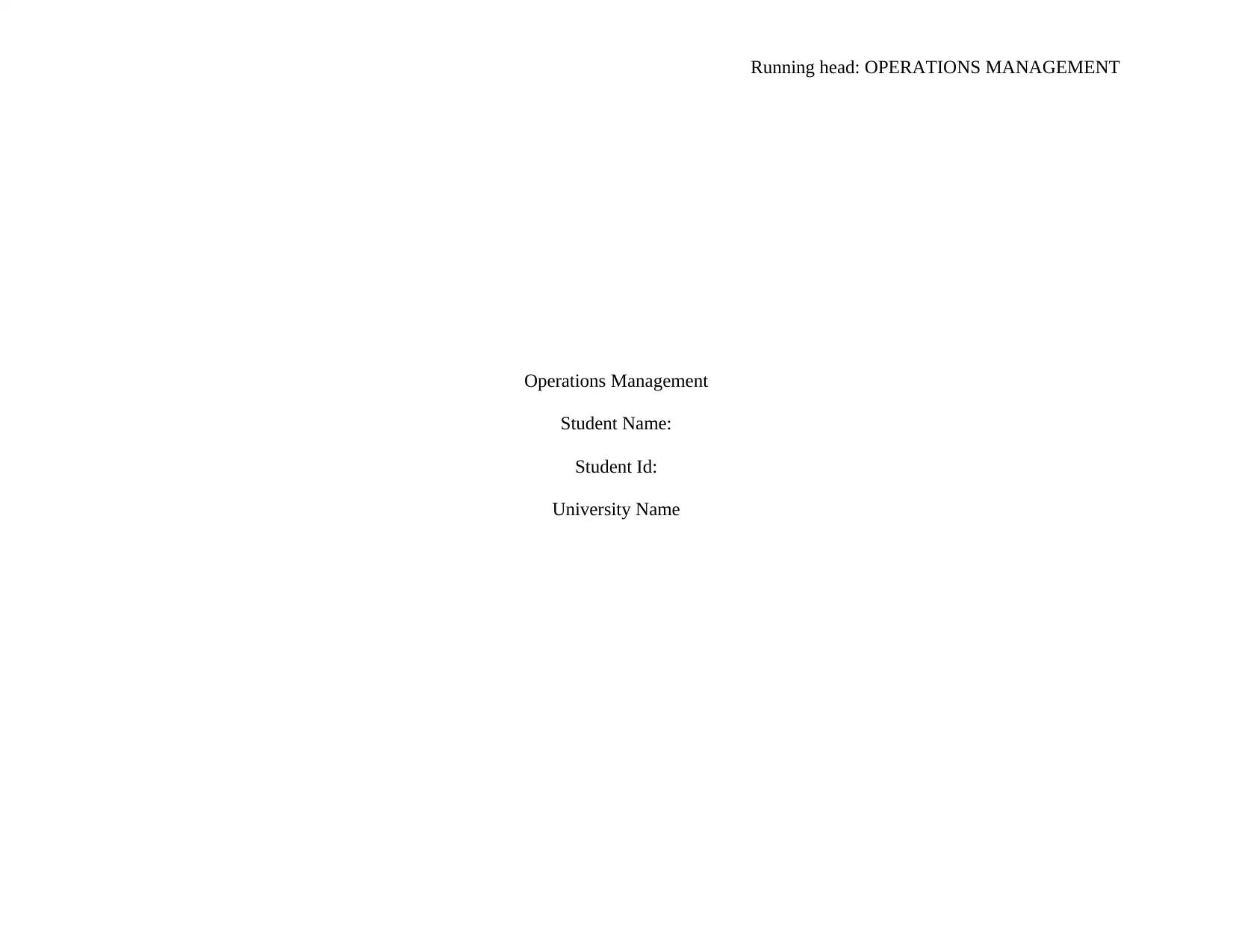
Running head: OPERATIONS MANAGEMENT
Operations Management
Student Name:
Student Id:
University Name
Operations Management
Student Name:
Student Id:
University Name
Paraphrase This Document
Need a fresh take? Get an instant paraphrase of this document with our AI Paraphraser
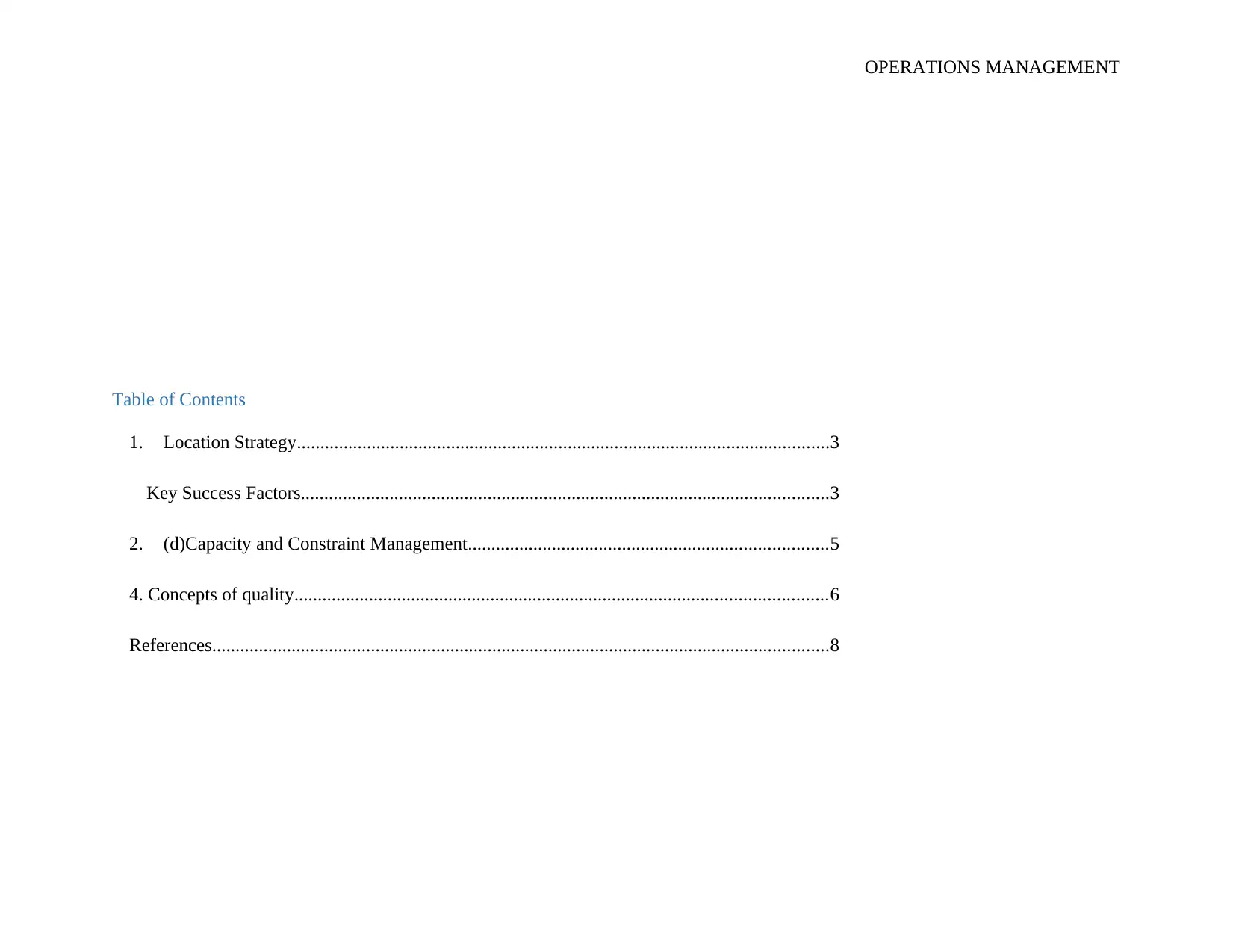
OPERATIONS MANAGEMENT
Table of Contents
1. Location Strategy..................................................................................................................3
Key Success Factors.................................................................................................................3
2. (d)Capacity and Constraint Management.............................................................................5
4. Concepts of quality..................................................................................................................6
References....................................................................................................................................8
Table of Contents
1. Location Strategy..................................................................................................................3
Key Success Factors.................................................................................................................3
2. (d)Capacity and Constraint Management.............................................................................5
4. Concepts of quality..................................................................................................................6
References....................................................................................................................................8
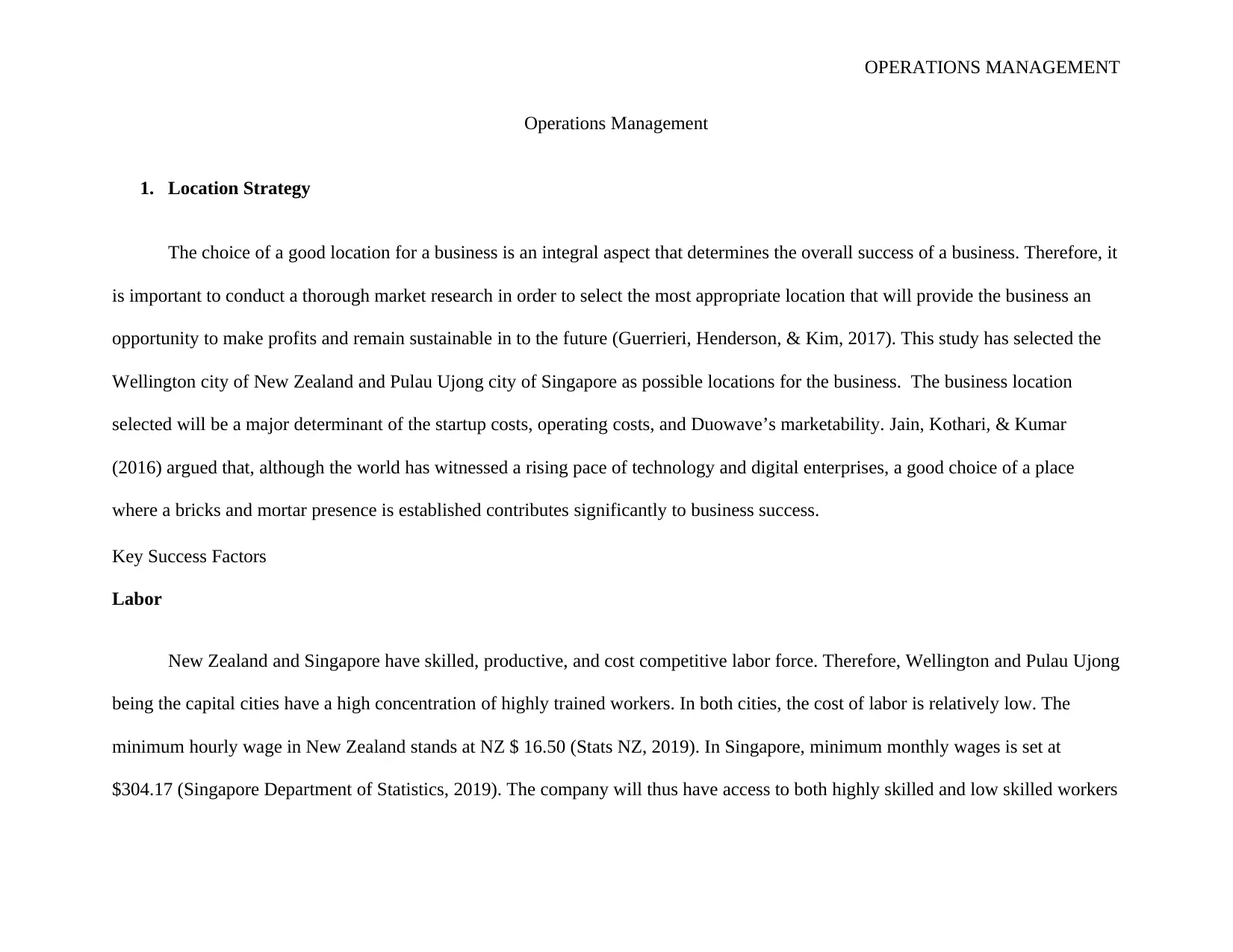
OPERATIONS MANAGEMENT
Operations Management
1. Location Strategy
The choice of a good location for a business is an integral aspect that determines the overall success of a business. Therefore, it
is important to conduct a thorough market research in order to select the most appropriate location that will provide the business an
opportunity to make profits and remain sustainable in to the future (Guerrieri, Henderson, & Kim, 2017). This study has selected the
Wellington city of New Zealand and Pulau Ujong city of Singapore as possible locations for the business. The business location
selected will be a major determinant of the startup costs, operating costs, and Duowave’s marketability. Jain, Kothari, & Kumar
(2016) argued that, although the world has witnessed a rising pace of technology and digital enterprises, a good choice of a place
where a bricks and mortar presence is established contributes significantly to business success.
Key Success Factors
Labor
New Zealand and Singapore have skilled, productive, and cost competitive labor force. Therefore, Wellington and Pulau Ujong
being the capital cities have a high concentration of highly trained workers. In both cities, the cost of labor is relatively low. The
minimum hourly wage in New Zealand stands at NZ $ 16.50 (Stats NZ, 2019). In Singapore, minimum monthly wages is set at
$304.17 (Singapore Department of Statistics, 2019). The company will thus have access to both highly skilled and low skilled workers
Operations Management
1. Location Strategy
The choice of a good location for a business is an integral aspect that determines the overall success of a business. Therefore, it
is important to conduct a thorough market research in order to select the most appropriate location that will provide the business an
opportunity to make profits and remain sustainable in to the future (Guerrieri, Henderson, & Kim, 2017). This study has selected the
Wellington city of New Zealand and Pulau Ujong city of Singapore as possible locations for the business. The business location
selected will be a major determinant of the startup costs, operating costs, and Duowave’s marketability. Jain, Kothari, & Kumar
(2016) argued that, although the world has witnessed a rising pace of technology and digital enterprises, a good choice of a place
where a bricks and mortar presence is established contributes significantly to business success.
Key Success Factors
Labor
New Zealand and Singapore have skilled, productive, and cost competitive labor force. Therefore, Wellington and Pulau Ujong
being the capital cities have a high concentration of highly trained workers. In both cities, the cost of labor is relatively low. The
minimum hourly wage in New Zealand stands at NZ $ 16.50 (Stats NZ, 2019). In Singapore, minimum monthly wages is set at
$304.17 (Singapore Department of Statistics, 2019). The company will thus have access to both highly skilled and low skilled workers
⊘ This is a preview!⊘
Do you want full access?
Subscribe today to unlock all pages.

Trusted by 1+ million students worldwide
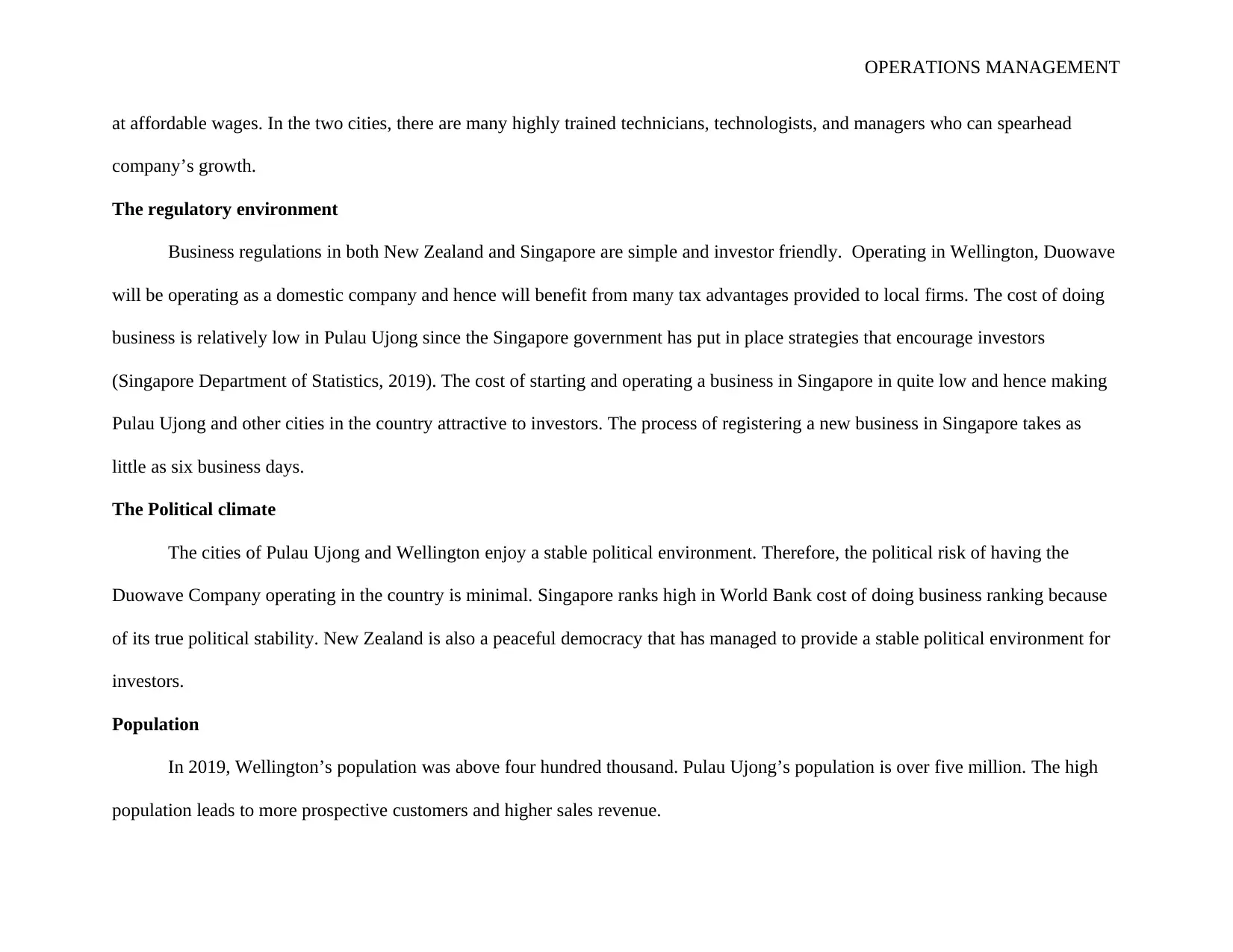
OPERATIONS MANAGEMENT
at affordable wages. In the two cities, there are many highly trained technicians, technologists, and managers who can spearhead
company’s growth.
The regulatory environment
Business regulations in both New Zealand and Singapore are simple and investor friendly. Operating in Wellington, Duowave
will be operating as a domestic company and hence will benefit from many tax advantages provided to local firms. The cost of doing
business is relatively low in Pulau Ujong since the Singapore government has put in place strategies that encourage investors
(Singapore Department of Statistics, 2019). The cost of starting and operating a business in Singapore in quite low and hence making
Pulau Ujong and other cities in the country attractive to investors. The process of registering a new business in Singapore takes as
little as six business days.
The Political climate
The cities of Pulau Ujong and Wellington enjoy a stable political environment. Therefore, the political risk of having the
Duowave Company operating in the country is minimal. Singapore ranks high in World Bank cost of doing business ranking because
of its true political stability. New Zealand is also a peaceful democracy that has managed to provide a stable political environment for
investors.
Population
In 2019, Wellington’s population was above four hundred thousand. Pulau Ujong’s population is over five million. The high
population leads to more prospective customers and higher sales revenue.
at affordable wages. In the two cities, there are many highly trained technicians, technologists, and managers who can spearhead
company’s growth.
The regulatory environment
Business regulations in both New Zealand and Singapore are simple and investor friendly. Operating in Wellington, Duowave
will be operating as a domestic company and hence will benefit from many tax advantages provided to local firms. The cost of doing
business is relatively low in Pulau Ujong since the Singapore government has put in place strategies that encourage investors
(Singapore Department of Statistics, 2019). The cost of starting and operating a business in Singapore in quite low and hence making
Pulau Ujong and other cities in the country attractive to investors. The process of registering a new business in Singapore takes as
little as six business days.
The Political climate
The cities of Pulau Ujong and Wellington enjoy a stable political environment. Therefore, the political risk of having the
Duowave Company operating in the country is minimal. Singapore ranks high in World Bank cost of doing business ranking because
of its true political stability. New Zealand is also a peaceful democracy that has managed to provide a stable political environment for
investors.
Population
In 2019, Wellington’s population was above four hundred thousand. Pulau Ujong’s population is over five million. The high
population leads to more prospective customers and higher sales revenue.
Paraphrase This Document
Need a fresh take? Get an instant paraphrase of this document with our AI Paraphraser
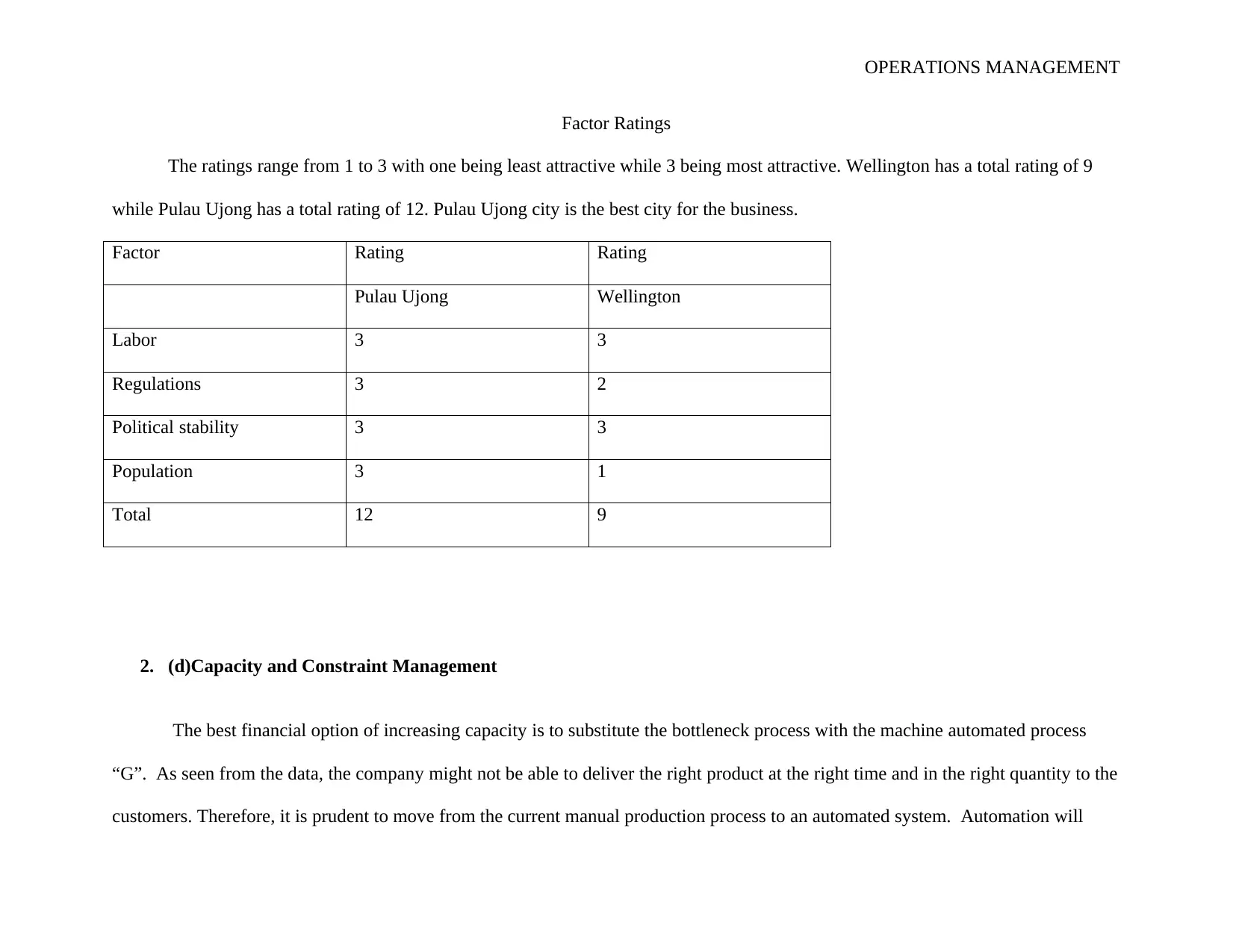
OPERATIONS MANAGEMENT
Factor Ratings
The ratings range from 1 to 3 with one being least attractive while 3 being most attractive. Wellington has a total rating of 9
while Pulau Ujong has a total rating of 12. Pulau Ujong city is the best city for the business.
Factor Rating Rating
Pulau Ujong Wellington
Labor 3 3
Regulations 3 2
Political stability 3 3
Population 3 1
Total 12 9
2. (d)Capacity and Constraint Management
The best financial option of increasing capacity is to substitute the bottleneck process with the machine automated process
“G”. As seen from the data, the company might not be able to deliver the right product at the right time and in the right quantity to the
customers. Therefore, it is prudent to move from the current manual production process to an automated system. Automation will
Factor Ratings
The ratings range from 1 to 3 with one being least attractive while 3 being most attractive. Wellington has a total rating of 9
while Pulau Ujong has a total rating of 12. Pulau Ujong city is the best city for the business.
Factor Rating Rating
Pulau Ujong Wellington
Labor 3 3
Regulations 3 2
Political stability 3 3
Population 3 1
Total 12 9
2. (d)Capacity and Constraint Management
The best financial option of increasing capacity is to substitute the bottleneck process with the machine automated process
“G”. As seen from the data, the company might not be able to deliver the right product at the right time and in the right quantity to the
customers. Therefore, it is prudent to move from the current manual production process to an automated system. Automation will
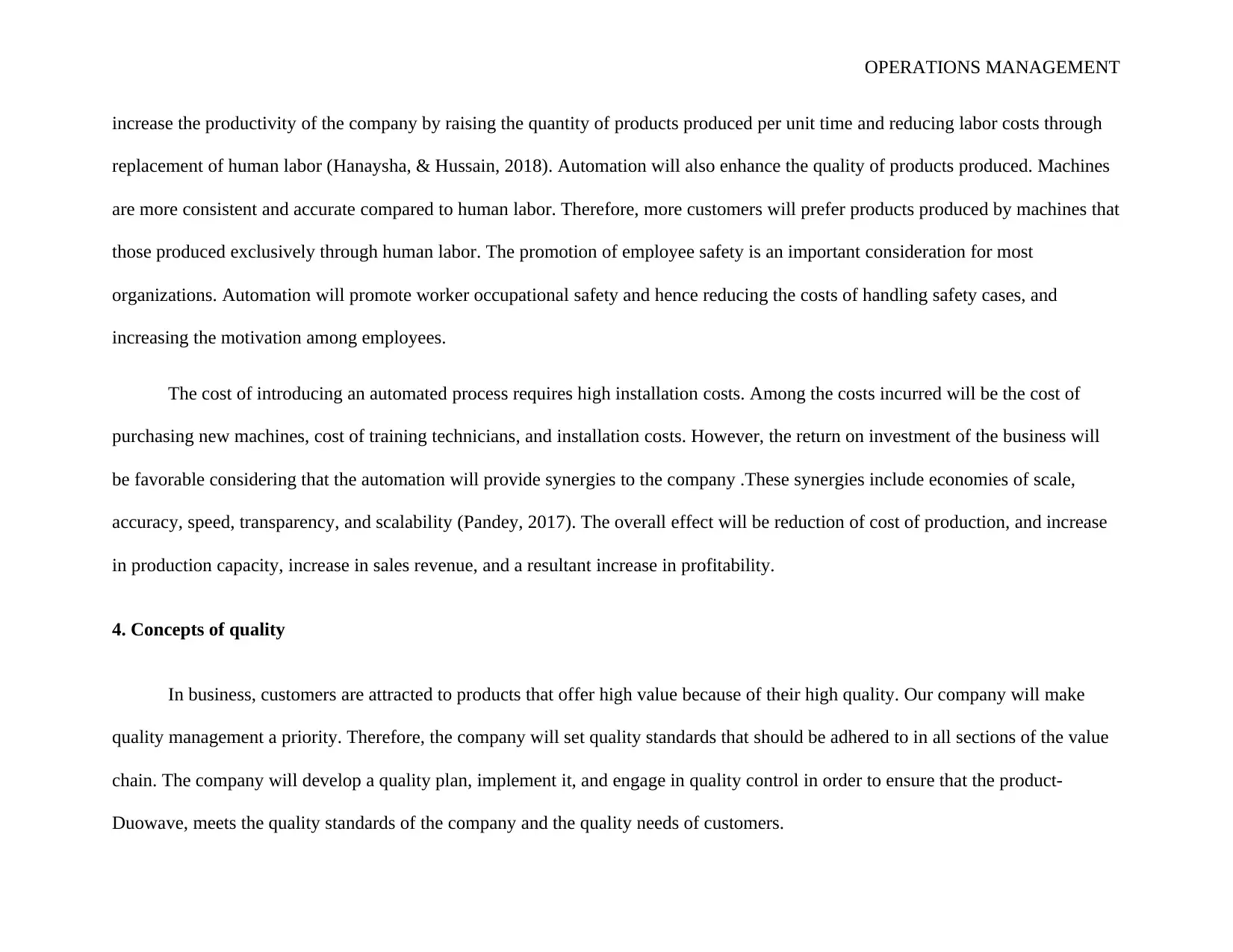
OPERATIONS MANAGEMENT
increase the productivity of the company by raising the quantity of products produced per unit time and reducing labor costs through
replacement of human labor (Hanaysha, & Hussain, 2018). Automation will also enhance the quality of products produced. Machines
are more consistent and accurate compared to human labor. Therefore, more customers will prefer products produced by machines that
those produced exclusively through human labor. The promotion of employee safety is an important consideration for most
organizations. Automation will promote worker occupational safety and hence reducing the costs of handling safety cases, and
increasing the motivation among employees.
The cost of introducing an automated process requires high installation costs. Among the costs incurred will be the cost of
purchasing new machines, cost of training technicians, and installation costs. However, the return on investment of the business will
be favorable considering that the automation will provide synergies to the company .These synergies include economies of scale,
accuracy, speed, transparency, and scalability (Pandey, 2017). The overall effect will be reduction of cost of production, and increase
in production capacity, increase in sales revenue, and a resultant increase in profitability.
4. Concepts of quality
In business, customers are attracted to products that offer high value because of their high quality. Our company will make
quality management a priority. Therefore, the company will set quality standards that should be adhered to in all sections of the value
chain. The company will develop a quality plan, implement it, and engage in quality control in order to ensure that the product-
Duowave, meets the quality standards of the company and the quality needs of customers.
increase the productivity of the company by raising the quantity of products produced per unit time and reducing labor costs through
replacement of human labor (Hanaysha, & Hussain, 2018). Automation will also enhance the quality of products produced. Machines
are more consistent and accurate compared to human labor. Therefore, more customers will prefer products produced by machines that
those produced exclusively through human labor. The promotion of employee safety is an important consideration for most
organizations. Automation will promote worker occupational safety and hence reducing the costs of handling safety cases, and
increasing the motivation among employees.
The cost of introducing an automated process requires high installation costs. Among the costs incurred will be the cost of
purchasing new machines, cost of training technicians, and installation costs. However, the return on investment of the business will
be favorable considering that the automation will provide synergies to the company .These synergies include economies of scale,
accuracy, speed, transparency, and scalability (Pandey, 2017). The overall effect will be reduction of cost of production, and increase
in production capacity, increase in sales revenue, and a resultant increase in profitability.
4. Concepts of quality
In business, customers are attracted to products that offer high value because of their high quality. Our company will make
quality management a priority. Therefore, the company will set quality standards that should be adhered to in all sections of the value
chain. The company will develop a quality plan, implement it, and engage in quality control in order to ensure that the product-
Duowave, meets the quality standards of the company and the quality needs of customers.
⊘ This is a preview!⊘
Do you want full access?
Subscribe today to unlock all pages.

Trusted by 1+ million students worldwide
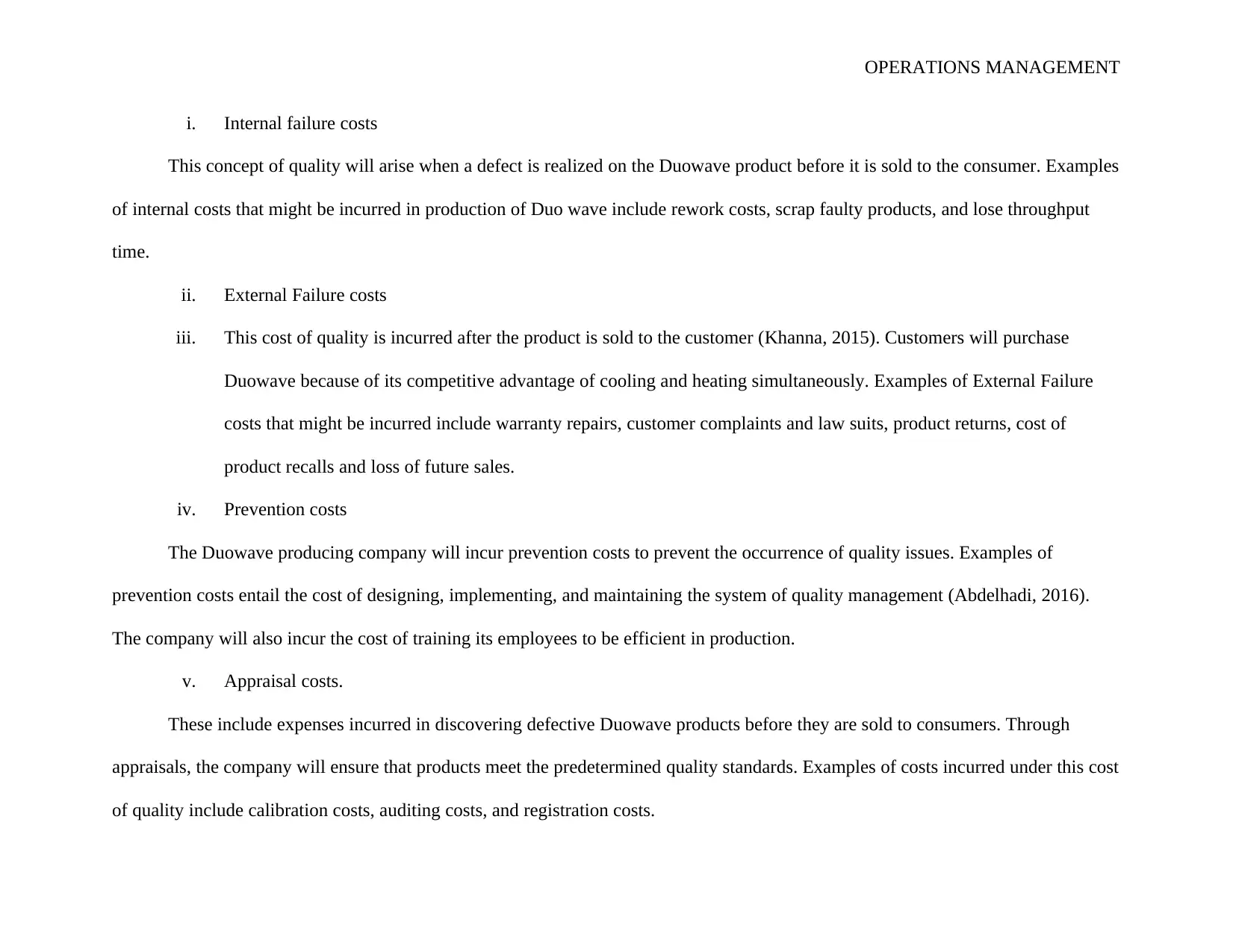
OPERATIONS MANAGEMENT
i. Internal failure costs
This concept of quality will arise when a defect is realized on the Duowave product before it is sold to the consumer. Examples
of internal costs that might be incurred in production of Duo wave include rework costs, scrap faulty products, and lose throughput
time.
ii. External Failure costs
iii. This cost of quality is incurred after the product is sold to the customer (Khanna, 2015). Customers will purchase
Duowave because of its competitive advantage of cooling and heating simultaneously. Examples of External Failure
costs that might be incurred include warranty repairs, customer complaints and law suits, product returns, cost of
product recalls and loss of future sales.
iv. Prevention costs
The Duowave producing company will incur prevention costs to prevent the occurrence of quality issues. Examples of
prevention costs entail the cost of designing, implementing, and maintaining the system of quality management (Abdelhadi, 2016).
The company will also incur the cost of training its employees to be efficient in production.
v. Appraisal costs.
These include expenses incurred in discovering defective Duowave products before they are sold to consumers. Through
appraisals, the company will ensure that products meet the predetermined quality standards. Examples of costs incurred under this cost
of quality include calibration costs, auditing costs, and registration costs.
i. Internal failure costs
This concept of quality will arise when a defect is realized on the Duowave product before it is sold to the consumer. Examples
of internal costs that might be incurred in production of Duo wave include rework costs, scrap faulty products, and lose throughput
time.
ii. External Failure costs
iii. This cost of quality is incurred after the product is sold to the customer (Khanna, 2015). Customers will purchase
Duowave because of its competitive advantage of cooling and heating simultaneously. Examples of External Failure
costs that might be incurred include warranty repairs, customer complaints and law suits, product returns, cost of
product recalls and loss of future sales.
iv. Prevention costs
The Duowave producing company will incur prevention costs to prevent the occurrence of quality issues. Examples of
prevention costs entail the cost of designing, implementing, and maintaining the system of quality management (Abdelhadi, 2016).
The company will also incur the cost of training its employees to be efficient in production.
v. Appraisal costs.
These include expenses incurred in discovering defective Duowave products before they are sold to consumers. Through
appraisals, the company will ensure that products meet the predetermined quality standards. Examples of costs incurred under this cost
of quality include calibration costs, auditing costs, and registration costs.
Paraphrase This Document
Need a fresh take? Get an instant paraphrase of this document with our AI Paraphraser
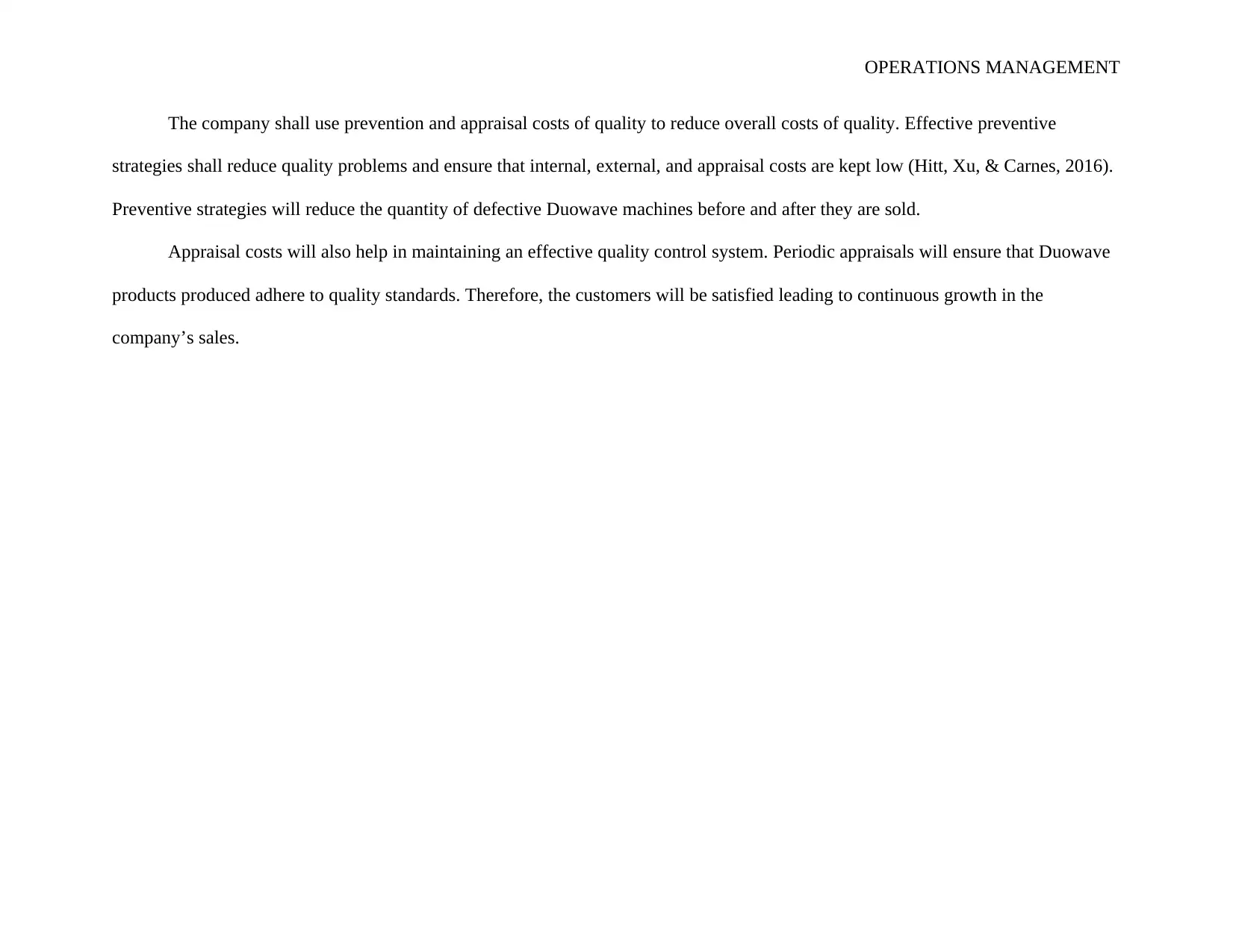
OPERATIONS MANAGEMENT
The company shall use prevention and appraisal costs of quality to reduce overall costs of quality. Effective preventive
strategies shall reduce quality problems and ensure that internal, external, and appraisal costs are kept low (Hitt, Xu, & Carnes, 2016).
Preventive strategies will reduce the quantity of defective Duowave machines before and after they are sold.
Appraisal costs will also help in maintaining an effective quality control system. Periodic appraisals will ensure that Duowave
products produced adhere to quality standards. Therefore, the customers will be satisfied leading to continuous growth in the
company’s sales.
The company shall use prevention and appraisal costs of quality to reduce overall costs of quality. Effective preventive
strategies shall reduce quality problems and ensure that internal, external, and appraisal costs are kept low (Hitt, Xu, & Carnes, 2016).
Preventive strategies will reduce the quantity of defective Duowave machines before and after they are sold.
Appraisal costs will also help in maintaining an effective quality control system. Periodic appraisals will ensure that Duowave
products produced adhere to quality standards. Therefore, the customers will be satisfied leading to continuous growth in the
company’s sales.
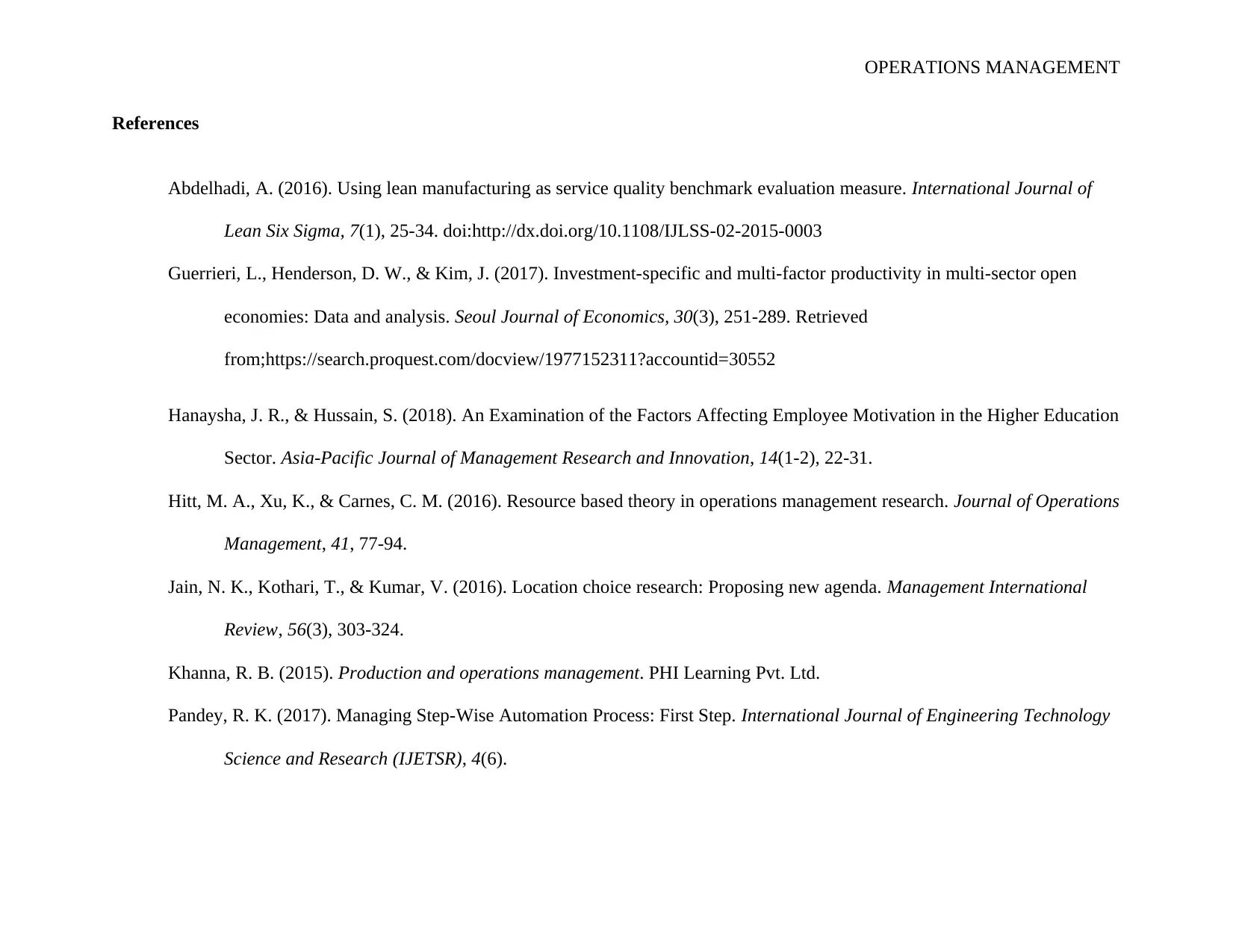
OPERATIONS MANAGEMENT
References
Abdelhadi, A. (2016). Using lean manufacturing as service quality benchmark evaluation measure. International Journal of
Lean Six Sigma, 7(1), 25-34. doi:http://dx.doi.org/10.1108/IJLSS-02-2015-0003
Guerrieri, L., Henderson, D. W., & Kim, J. (2017). Investment-specific and multi-factor productivity in multi-sector open
economies: Data and analysis. Seoul Journal of Economics, 30(3), 251-289. Retrieved
from;https://search.proquest.com/docview/1977152311?accountid=30552
Hanaysha, J. R., & Hussain, S. (2018). An Examination of the Factors Affecting Employee Motivation in the Higher Education
Sector. Asia-Pacific Journal of Management Research and Innovation, 14(1-2), 22-31.
Hitt, M. A., Xu, K., & Carnes, C. M. (2016). Resource based theory in operations management research. Journal of Operations
Management, 41, 77-94.
Jain, N. K., Kothari, T., & Kumar, V. (2016). Location choice research: Proposing new agenda. Management International
Review, 56(3), 303-324.
Khanna, R. B. (2015). Production and operations management. PHI Learning Pvt. Ltd.
Pandey, R. K. (2017). Managing Step-Wise Automation Process: First Step. International Journal of Engineering Technology
Science and Research (IJETSR), 4(6).
References
Abdelhadi, A. (2016). Using lean manufacturing as service quality benchmark evaluation measure. International Journal of
Lean Six Sigma, 7(1), 25-34. doi:http://dx.doi.org/10.1108/IJLSS-02-2015-0003
Guerrieri, L., Henderson, D. W., & Kim, J. (2017). Investment-specific and multi-factor productivity in multi-sector open
economies: Data and analysis. Seoul Journal of Economics, 30(3), 251-289. Retrieved
from;https://search.proquest.com/docview/1977152311?accountid=30552
Hanaysha, J. R., & Hussain, S. (2018). An Examination of the Factors Affecting Employee Motivation in the Higher Education
Sector. Asia-Pacific Journal of Management Research and Innovation, 14(1-2), 22-31.
Hitt, M. A., Xu, K., & Carnes, C. M. (2016). Resource based theory in operations management research. Journal of Operations
Management, 41, 77-94.
Jain, N. K., Kothari, T., & Kumar, V. (2016). Location choice research: Proposing new agenda. Management International
Review, 56(3), 303-324.
Khanna, R. B. (2015). Production and operations management. PHI Learning Pvt. Ltd.
Pandey, R. K. (2017). Managing Step-Wise Automation Process: First Step. International Journal of Engineering Technology
Science and Research (IJETSR), 4(6).
⊘ This is a preview!⊘
Do you want full access?
Subscribe today to unlock all pages.

Trusted by 1+ million students worldwide
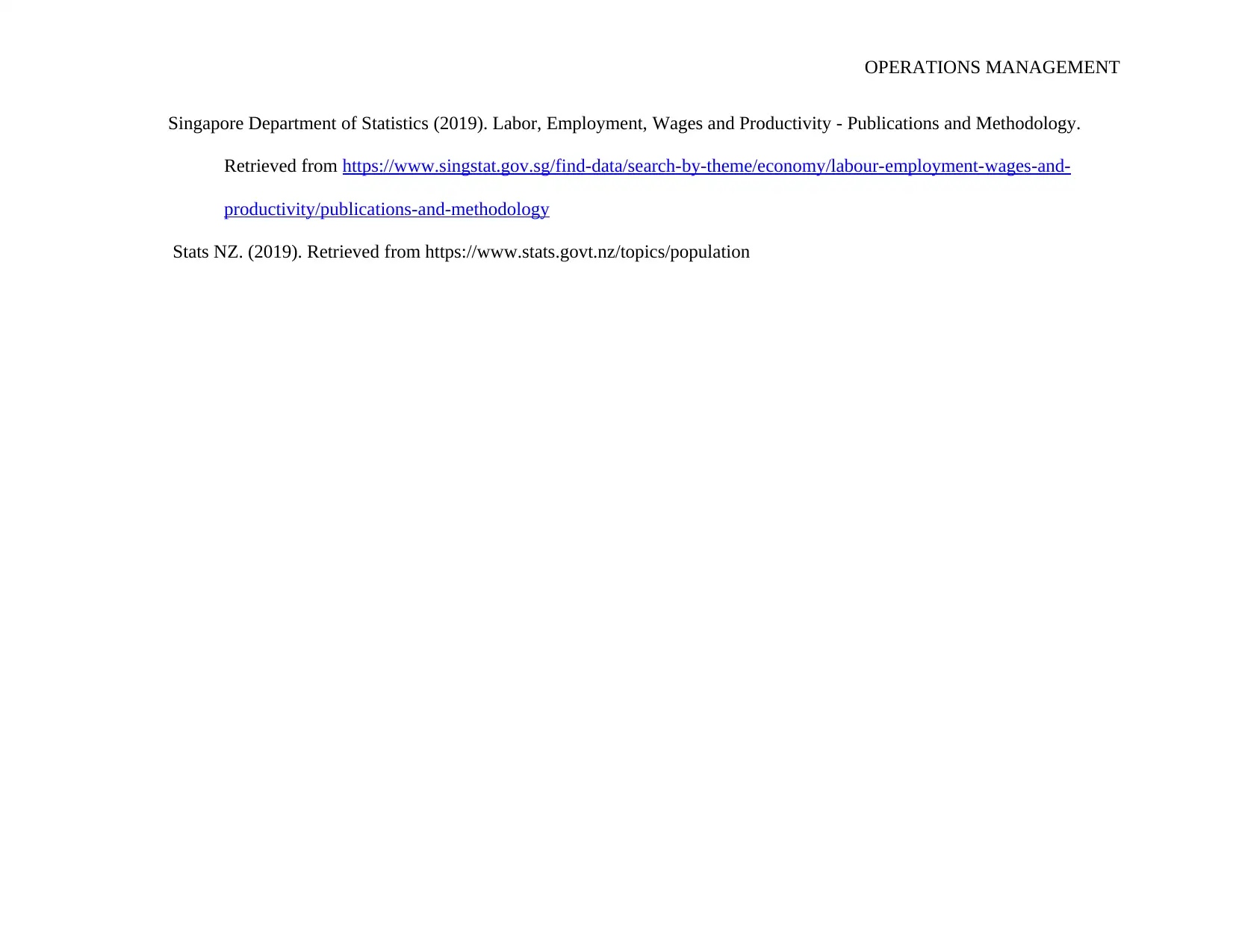
OPERATIONS MANAGEMENT
Singapore Department of Statistics (2019). Labor, Employment, Wages and Productivity - Publications and Methodology.
Retrieved from https://www.singstat.gov.sg/find-data/search-by-theme/economy/labour-employment-wages-and-
productivity/publications-and-methodology
Stats NZ. (2019). Retrieved from https://www.stats.govt.nz/topics/population
Singapore Department of Statistics (2019). Labor, Employment, Wages and Productivity - Publications and Methodology.
Retrieved from https://www.singstat.gov.sg/find-data/search-by-theme/economy/labour-employment-wages-and-
productivity/publications-and-methodology
Stats NZ. (2019). Retrieved from https://www.stats.govt.nz/topics/population
1 out of 10
Related Documents
Your All-in-One AI-Powered Toolkit for Academic Success.
+13062052269
info@desklib.com
Available 24*7 on WhatsApp / Email
![[object Object]](/_next/static/media/star-bottom.7253800d.svg)
Unlock your academic potential
Copyright © 2020–2025 A2Z Services. All Rights Reserved. Developed and managed by ZUCOL.





